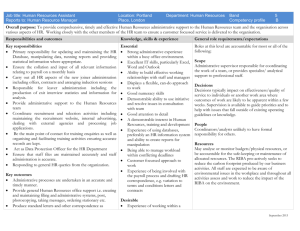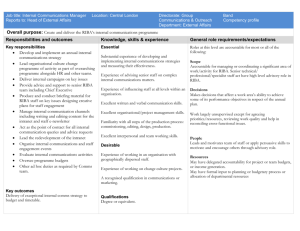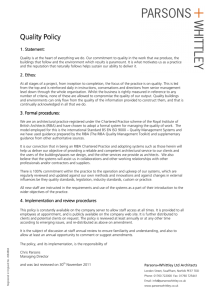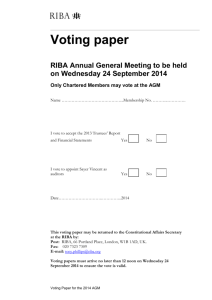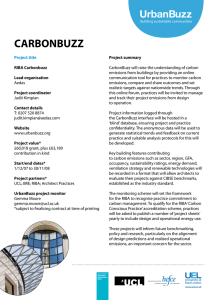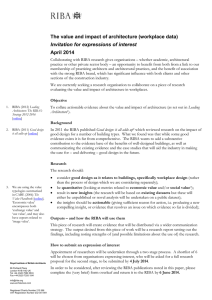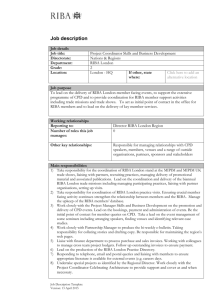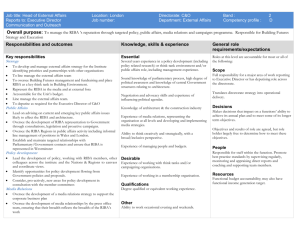RIBA project quality plan for small projects
advertisement
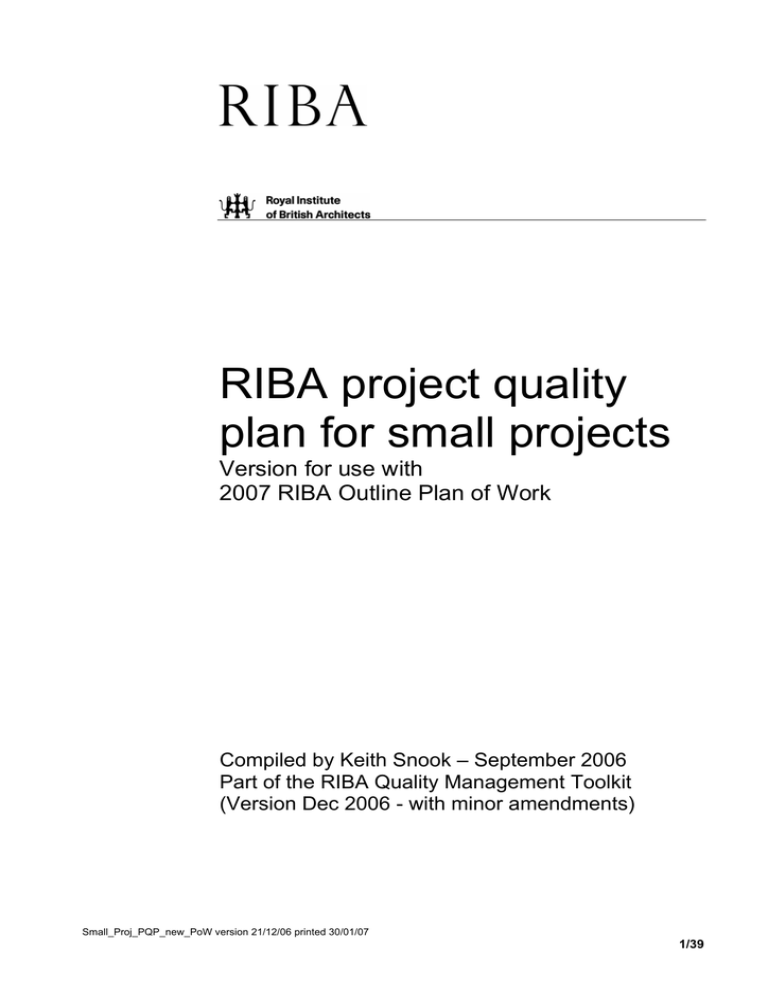
RIBA project quality plan for small projects Version for use with 2007 RIBA Outline Plan of Work Compiled by Keith Snook – September 2006 Part of the RIBA Quality Management Toolkit (Version Dec 2006 - with minor amendments) Small_Proj_PQP_new_PoW version 21/12/06 printed 30/01/07 1/39 The RIBA Quality Management Toolkit – RIBA project quality plan for small projects Section one - instructional INSTRUCTIONAL MATERIAL Small_Proj_PQP_new_PoW version 21/12/06 printed 30/01/07 2/39 The RIBA Quality Management Toolkit – RIBA project quality plan for small projects PREAMBLE The RIBA Quality Management System – Project Quality Planning for small projects adopts a process approach and has been developed as a tool to be primarily used by practices electronically. This version incorporates the 2007 version of the RIBA Outline Plan of Work. It is an MS word document that is very simple to operate and will provide benefits to the practice. The sequence is less relevant to an electronic document than to a paper one but for reference/information the order is as follows: Section one - instructional Title Page Preamble Introduction – explanatory text:A Rose by any other name The ‘knocked down by a bus’ test The quality plan Elements of a quality plan Using the RIBA Project Quality Plan for small Projects Section two –project related model documents Short form quality plan Quality Plan Title page Project particulars Consultants Contractors/Suppliers Programme Design review report Record of amendments to brief/Schedule of requirements Schedule of significant meetings and events Project responsibilities checklist Section three – reference material - support procedures Commission Project naming and numbering Design reviews Project document protocols Section four – reference material – data and guidance Consultants – track record Contractors/suppliers track record List of project Numbers Procurement systems RIBA Outline Plan of Work Working at Risk The presentation provides internal links from enquiry points (bookmarks) to reference points as necessary by way of hyperlinks. Some links to useful external sources are also provided such as: Web-site of Co-ordinating Committee for Project Information for access to the full text of the Code of Procedure for Production Information. Web-site of the Usable Buildings organisation for advice on collection and use of feedback data RIBA bookshop – access for on line purchase of support documents. Building Cost Information Service – an on line subscription service available to RIBA Chartered Practices for assistance in cost estimating British Standards Institution – reference to the International Standard “BS EN ISO 9001 2000 Quality Management Systems” Simple instruction on adding your own internal or external links are included though this does assume basic knowledge of MS Word. INSTRUCTIONAL MATERIAL Small_Proj_PQP_new_PoW version 21/12/06 printed 30/01/07 3/39 The RIBA Quality Management Toolkit – RIBA project quality plan for small projects RIBA - PROJECT QUALITY PLANNING FOR SMALL PROJECTS INTRODUCTION “A Rose by any other name ….” The RIBA Project Quality Plan for Small Projects (PQPSP) is a useful management control mechanism and not to be seen as “additional documentation required for QA". It may even help in understanding the concept of the project quality plan to relate it to a ‘design plan’ or some other more familiar term particularly if, as you read-on, you recognise all the steps as something you do anyway - but under another name. For presentation purposes we have established terms and used them consistently. One advantage in our terms is that where clients have an interest in or knowledge of the subject they will understand them. However if they really understand they will also know that the important thing about quality management is that it is done - and done in the normal course of events– not what lexicon it uses. The “knocked-down by a bus” test Most of the requirements for project quality planning are probably already satisfied in a well-regulated practice, for example by following the “Architects Job Book”, and the evidence located somewhere in the files. In a properly operating quality system, all the relevant information will be readily available. In pure QM terms this is important in order to be able to demonstrate compliance but this is of course not the reason for doing it. If it is, the system will quickly fail the practice. A hypothetical, test that may be applied is that it should be implicit that in a practice operating good systems that other technically competent people (from within or without) should be able to take over a project at short notice should the need arise, and be able to maintain the specified program, service and performance. The ‘what happens if ‘Fred’ is knocked-down by a bus’ test! The Project Quality Plan It is not too difficult to create a sequence of processes and activities that are logical and can be followed by others. The already familiar RIBA Outline Plan of Work provides such a framework for a project quality plan for architecture and indeed all building design activities. It has stood the test of time and has been adopted in whole or part by other disciplines and the basic stages A to L have become a de-facto process map for any building design project. It is also the intellectual property of the RIBA and its development is closely linked to feedback from the profession including from its use for purposes such as this. For these reasons it is adopted in this model as the framework for the project process. Projects are frequently intermittent in nature and without a plan keeping track can be difficult. A commission may initially be for a ‘partial service’ eg a feasibility study, or to determine a brief only and subsequently may not be extended. This gives good reasons for project quality plans to be prepared and continually reviewed and updated. It may be possible to standardise some elements of a quality plan and if responsibilities for particular tasks are defined elsewhere (eg in written procedures) the quality plan need only identify the task and the personnel. Similarly information may exist elsewhere eg the schedule of requirements may be filed in say, the client file. The quality plan need simply identify that file. The quality objectives of the practice may be common to all projects and be defined in a policy statement. However, those for a project have to reflect the values of the ‘client’ (funder, user and others) and this may be best recorded in the quality plan. Elements Of A Quality Plan. Quality plans should: a) Record of the Project Details – name, address and brief description of the project; name, address and responsibilities of: - the client - other design team members - specialist consultants INSTRUCTIONAL MATERIAL Small_Proj_PQP_new_PoW version 21/12/06 printed 30/01/07 4/39 The RIBA Quality Management Toolkit – RIBA project quality plan for small projects - - contractors suppliers. b) Definition of the client’s brief to include outline of the client’s requirements including: any schedules of accommodation cost plan or limits program or time limits any key design development and construction constraints agreed level of specification(cost/durability and particularly deviations from norms or standards.) c) Definition of the Scope of Services to be provided by the Chartered Practice for the project (generally based on the RIBA Outline Plan of Work). d) Record of any critical processes/procedures to be followed, particularly where they differ from accepted normal office practice. e) Definition of approval/verification activities such as design reviews, drawing and other document checks, submissions to statutory authorities, client presentations and approvals. - f) Record of Changes and updates on progress relating to the agreed project plan or client’s brief team members any other variations. The Quality Plan should be reviewed and updated at programmed intervals, usually related to plan of work stages and at the time of any significant individual changes. g) Record of any other special actions necessary to meet the project objectives and any unusual circumstances or uncertainties about the project which require further investigations. h) Methods of measuring achievement in the design and production processes, particularly on project completion and monitoring client satisfaction through the project, Including record of dealing with any client complaint The above requirements may seem onerous when applied to a job that may be completed by one person in a couple of weeks. For a small project, the quality plan may just be a few structured notes (which can be hand written) in the front of the project file. A suggested format is provided at the following link PQPShort. Quality systems only require legible/intelligible documents of the appropriate level of rigour, not necessarily word-processed ones! It may be found useful if the other documents for the project that demonstrate that the quality plan has been followed are filed with, or as part of, the quality planning document. These may include the brief and brief change control documents, statutory approvals, client approvals, design review records, checking records, programs, progress records and architect’s instructions. Alternatively they may be referenced using an office filing system. INSTRUCTIONAL MATERIAL Small_Proj_PQP_new_PoW version 21/12/06 printed 30/01/07 5/39 The RIBA Quality Management Toolkit – RIBA project quality plan for small projects USING THE RIBA PROJECT QUALITY PLAN FOR SMALL PROJECTS NB A basic working knowledge of MS Word operation is assumed and it may be helpful to refer also to Microsoft ‘Help’ function. Follow links for more detailed definitions. Updates From time to time the system will be updated on the RIBA web site Procedure for use: 1. Download a copy from the RIBA web site 2. Create a template and make any generic adjustments to suit the practice. The base document contains internal and external links note that these may be affected by any amendment you may make. For project use: 3. Rename a copy using the file identifier for the project. The Identifier is a project number and short version of the project name e.g. Fallingwater 35/123. Enter footer and check that the file is now automatically re named. 4. While in footer manually key version status indicator. The system in the toolkit uses the date ddmmyy with no spaces – you may have your own way of doing this. The ‘printed date’ is simply automatically linked to the computer clock and records the date on any printed version of the document or part of it. 5. Title page: Insert the name and number of the Project and a date of inception of the commission. 6. The tables for Project particulars Consultants Contractors/Suppliers are all MS Word tables and cells will expand to accommodate entries. They are all relatively straightforward. You may already have this information in other files that you can either import or use from that source (instructions for such IT operations are beyond the scope of this section). 7. The same applies to the other tabular formats Commission/Programme Design Review Report Amendments to Brief Schedule of meetings 8. The table of activities entitled ‘Project responsibilities ‘ may be amended to create a bespoke version for the project. Similarly a new practice master list can be used to replace the one provided. Again it is a simple MS Word table. Project 1 RIBA Base document Download/ Customise > Your Base document Rename/ Complete/ Follow > Project 3 Project 2 etc. INSTRUCTIONAL MATERIAL Small_Proj_PQP_new_PoW version 21/12/06 printed 30/01/07 6/39 The RIBA Quality Management Toolkit – RIBA project quality plan for small projects Amending the links 1 1.1 1.2 2 2.1 Creating new internal links: Create a ‘Bookmark’ at the point to be linked-to either in the same or other accessible document:Highlight one word Choose ‘Insert’ menu and ‘Create bookmark’ Name bookmark in dialogue box and close and revert to document. Create a ‘Hyperlink’ to that point Highlight the word to be linked-from Choose ‘Insert’ menu and ‘Create hyperlink’ In the dialogue box browse for the name of the appropriate bookmark and select, close and revert to document. Test the operation of the link. Creating new external links: Create a ‘Hyperlink’ to that source Highlight the word to be linked-from Choose ‘Insert’ menu and ‘Create hyperlink’ In the dialogue box type or otherwise insert the URL for the link required. Test the link. INSTRUCTIONAL MATERIAL Small_Proj_PQP_new_PoW version 21/12/06 printed 30/01/07 7/39 The RIBA Quality Management Toolkit – RIBA project quality plan for small projects Section two –project related model documents MODEL DOCUMENTS Small_Proj_PQP_new_PoW version 21/12/06 printed 30/01/07 8/39 The RIBA Quality Management Toolkit – RIBA project quality plan for small projects Project Quality Plan for Small Projects– Short Form for use on qualifying projects only. QMT/PQPSP/PQPshort No.: ………….. Date: Project: Status: ……… By: Client: ITEM Client requirements/instructions: PEOPLE INVOLVED DATES Received/ Confirmed: Scope of work: Refs to other docs: Appointment: Programme: Correspondence: ….. ….. Staffing: Tasks (including checking as appropriate) ….. Design, progress or any other reviews/audits required for project: …. …. …… Application of procedures/protocols: This plan presumes the application of normal office procedures at an appropriate degree of rigor to suit the commission: Variances from above statement: 1 2 3 4 Key decisions/changes MODEL DOCUMENTS Small_Proj_PQP_new_PoW version 21/12/06 printed 30/01/07 9/39 The RIBA Quality Management Toolkit – RIBA project quality plan for small projects QUALITY PLAN FOR CLIENT Outline pro-forma for you to adjust to your own way of working and schedules MODEL DOCUMENTS Small_Proj_PQP_new_PoW version 21/12/06 printed 30/01/07 10/39 The RIBA Quality Management Toolkit – RIBA project quality plan for small projects PROJECT PARTICULARS QMT/PQPSP/Particulars PROJECT NAME PROJECT NO CLIENT ADDRESS TELEPHONE NO FAX NO EMAIL CONTACTS (Key representatives) POSITION/ RESPONSIBILITY (poss refer to chart) TELEPHONE NO MOBILE NO ADDITIONAL INFORMATION Details of the commission Enter details of the commission referring to the agreed brief and any correspondence or other files as necessary such as design review regime. CDM Regulations Project Notifiable Location of H&S Plan/File ………………………………………………………. Notes: Y/N Appointed as Planning Supervisor Y / N (if ‘yes’ see separate Quality Plan for this function) MODEL DOCUMENTS Small_Proj_PQP_new_PoW version 21/12/06 printed 30/01/07 11/39 The RIBA Quality Management Toolkit – RIBA project quality plan for small projects CONSULTANTS QMT/PQPSP/Consultants 1 DISCIPLINE PRACTICE NAME ADDRESS Email Web Tel CONTACTS POSITION/ RESPONSIBILITY Tel Mob Email ADDITIONAL INFORMATION Details of the consultant’s commission particularly level of service and its relationship to your own . MODEL DOCUMENTS Small_Proj_PQP_new_PoW version 21/12/06 printed 30/01/07 12/39 The RIBA Quality Management Toolkit – RIBA project quality plan for small projects CONTRACTORS/SUPPLIERS QMT/PQPSP/Contractors/Suppliers 1 DESCRIPTION NAME ADDRESS Email Web Tel CONTACTS POSITION/ RESPONSIBILITY Tel Mob Email ADDITIONAL INFORMATION Details of the contract and scope of works/supply MODEL DOCUMENTS Small_Proj_PQP_new_PoW version 21/12/06 printed 30/01/07 13/39 The RIBA Quality Management Toolkit – RIBA project quality plan for small projects COMMISSION/PROGRAMME Procurement method: ……………………………………………. WORK STAGE DESIGN AND OTHER REVIEWS (type/scope/date) START (dates) PLANNED/ACHIEVED COMPLETE (dates) PLANNED/ACHIEVED QMT/PQPSP/Prog INITIALS (inc. client approval as nec) COMMENTS PRE CONSTRUCTION A: Appraisal B: Developed Brief C: Concept D: Design Development E: Technical Design F: Production Information F1 for construction F2 further as req. G: Tender Documentation H: Tender Action USE J: Mobilisation K: to Practical Completion L: Post Practical Completion L1 final inspections and admin L2 assisted occupation L3 performance in use Other Services MODEL DOCUMENTS Small_Proj_PQP_new_PoW version 21/12/06 printed 30/01/07 14/39 The RIBA Quality Management Toolkit – RIBA project quality plan for small projects QMT/PQPSP/Des. Rev. DESIGN REVIEW REPORT Undertaken by: Present:: Date: Stage: DESCRIPTION Yes/ No ACTION ACTION BY ACTION COMPLETE Have all the points on the Design Check List been addressed? Have all statutory and regulatory requirements been included? Are the project timescales being achieved? Have there been any changes to client requirements? If yes record on record of amendment sheet. Have the changes above been approved in writing? Additional Comments MODEL DOCUMENTS Small_Proj_PQP_new_PoW version 21/12/06 printed 30/01/07 15/39 The RIBA Quality Management Toolkit – RIBA project quality plan for small projects RECORD OF AMENDMENTS TO BRIEF/SCHEDULE OF REQUIREMENTS DATE QMT/PQPSP/Brief Amnd. ACTION BRIEF DESCRIPTION OF AMENDMENT and ACTIONS INITIALS DATE MODEL DOCUMENTS Small_Proj_PQP_new_PoW version 21/12/06 printed 30/01/07 16/39 The RIBA Quality Management Toolkit – RIBA project quality plan for small projects SHEDULE/RECORD OF SIGNIFICANT MEETINGS AND EVENTS QMT/PQPSP/Meetings DATE LOCATION BRIEF DESCRIPTION OF MEETING/EVENT INITIALS MODEL DOCUMENTS Small_Proj_PQP_new_PoW version 21/12/06 printed 30/01/07 17/39 The RIBA Quality Management Toolkit – RIBA project quality plan for small projects PROJECT RESPONSIBILITIES CHECK LIST A Appraisal Identification of client’s needs and objectives, business case and possible constraints on development. ……………… Principal WHAT v Delete-from / Add-to list as appropriate to project ……………… QMT/PQPSP/Proj. Check List WHO > DOCUMENT REFERENCES, LINKS & NOTES Client initial brief Preparation of feasibility studies and assessment of options to enable the client to decide whether to proceed. Scheme administration –formalise appointment commission appointment contract Prepare Preliminary programme programme Collect data supplied by owner/client Undertake consultation with authorities Check if project notifiable under CDM Regulaltions CDM Propose/obtain/undertake surveys (list) surveys Check economic viability – confirm client budget BCIS Check position wrt scheme finance availability Undertake assessment of procurement methods Procurement Consider/propose possible consultants ConsultantTR Prepare Inception briefing report ……………………………………….. B Developed Brief Development of initial statement of requirements into the Developed Brief by or on behalf of the client confirming key requirements and constraints. Identification of procurement method, procedures, organisational structure and range of consultants and others to be engaged for the project Administration Undertake/obtain surveys (list) Surveys Collect further data supplied by owner/client Check availability of services Authorities: consultations with (list) Undertake strategic design review Prepare Feasibility briefing report(s) ………………………………………… MODEL DOCUMENTS Small_Proj_PQP_new_PoW version 21/12/06 printed 30/01/07 18/39 The RIBA Quality Management Toolkit – RIBA project quality plan for small projects C Concept Implementation of Developed Brief and preparation of additional data. Preparation of concept design including outline proposals for structural and building services systems, outline specifications and preliminary cost plan. Review of procurement route Administration Undertake materials research and prepare outline specification statements Prepare initial architectural design Prepare/procure structural design to respond to above Prepare/procure services design to respond to above Prepare/procure initial landscape and external works proposals Consider access & transportation Issues Prepare/procure cost plan BCIS Undertake co-ordination and checking Undertake design review Design review Prepare outline scheme report Obtain owner/client approval Prepare/submit application for outline planning permission …………………………………………….. D Design Development Development of concept design to include structural and building services systems, updated outline specifications and cost plan. planning The activities in italics may be moved to suit project requirements Completion of final Brief. Application for detailed planning permission Administration Prepare Architectural design Prepare/procure Structural design Prepare/procure Landscape design Prepare/procure Services design Prepare/procure Interior design Prepare/procure Cost plan Undertake co-ordination and checking Undertake Design review (including health and safety aspects of design) Prepare Scheme design report BCIS checking H&S Pursue approvals ………………………………………………….. MODEL DOCUMENTS Small_Proj_PQP_new_PoW version 21/12/06 printed 30/01/07 19/39 The RIBA Quality Management Toolkit – RIBA project quality plan for small projects E Technical Design Preparation of technical design(s) and specifications, sufficient to co-ordinate components and elements of the project and information for statutory standards. Administration Pursue Planning and building regulations requirements Collect further data supplied by owner/client Prepare Architectural design Prepare/procure Structural design Prepare/procure Landscape design Prepare/procure Services design Prepare/procure Interior design Make preliminary arrangements for contract management Undertake/procure cost checking function BCIS Undertake technical reviews Undertake co-ordination and checking Prepare and make Presentations ………………………………………. F Production Information F1 Preparation of detailed information for construction. Application for statutory approvals. F2 Preparation of further information for construction required under the building contract. Review of information provided by specialists The activities in italics may be moved to suit project requirements Administration Prepare Contract documentation and tender information Prepare/procure preparation of Bills of quantities, schedules of rates or other pricing information Prepare Architectural - project information (drawings/specifications) Prepare/procure Structural engineering - project information (drawings/specifications) Prepare/procure Landscaping - project information (drawings/specifications) Prepare/procure Services engineering - project information (drawings/specifications) Undertake Co-ordination and checking CPIC Project information appraisal G Tender Documentation Preparation and/or collation of tender documentation in sufficient detail to enable a tender or tenders to be obtained for the project The activities in italics may be moved to suit project requirements Prepare Architectural - tender documentation Prepare/procure Structural engineering - tender documentation MODEL DOCUMENTS Small_Proj_PQP_new_PoW version 21/12/06 printed 30/01/07 20/39 The RIBA Quality Management Toolkit – RIBA project quality plan for small projects Prepare/procure Services engineering - tender documentation Prepare tender lists - main contract Consider demolition and/or enabling works contracts …………………………………………. H Tender action Identification and evaluation of potential contractors and/or specialists for the project. Obtaining and appraising tenders; submission of recommendations to the client The activities in italics may be moved to suit project requirements Administration Convene pre-tender meetings Answer questions (from tenderers) Apply agree procedure (NJCC?) for opening of tenders ………………………………………….. J Mobilisation Letting the building contract, appointing the contractor. Issuing of information to the contractor. Arranging site hand over to the contractor. Administration Check any outstanding items related to the site Undertake briefings of key participants (consultants, general contractors, specialist contractors etc) ………………………………………….. K Construction to Practical Completion Administration of the building contract to Practical Completion Provision to the contractor of further Information as and when reasonably required. Review of information provided by contractors and specialists Issue all information/instructions Where applicable provide information for health and Safety file (CDM Regs) and/or for Building Log Book (Building Regulations part L2) Prepare/implement quality control regime including onsite observation/inspection Prepare/implement Cost control regime CDM Issue Certificates Conduct/attend meetings Monitor progress and programme Respond to enquiries from client/users Respond to enquiries from construction team Attend design meetings ………………………………………………… MODEL DOCUMENTS Small_Proj_PQP_new_PoW version 21/12/06 printed 30/01/07 21/39 The RIBA Quality Management Toolkit – RIBA project quality plan for small projects L Post Practical Completion L1 L2 L3 Administration of the building contract after Practical Completion and making final inspections. Assisting building user during initial occupation period Review of project performance in use Administration Issue certificates and final certificates Undertake site inspection/observation Prepare materiel for archive Collect/analyse/act on client feedback Analyse/act on performance of completed works (including aspects of construction related to design) Analyse/act on Performance of project design team Analyse/act on Performance of construction team Analyse/act on contractual relationships Analyse/act on office costs Undertake continuing feedback (without prejudice) ……………………………………………………… MODEL DOCUMENTS Small_Proj_PQP_new_PoW version 21/12/06 printed 30/01/07 22/39 The RIBA Quality Management Toolkit – RIBA project quality plan for small projects Section three Reference material - support procedures REFERENCE MATERIAL Small_Proj_PQP_new_PoW version 21/12/06 printed 30/01/07 23/39 The RIBA Quality Management Toolkit – RIBA project quality plan for small projects USE OF THE SHORT FORM QUALITY PLAN SFQP This short form has two principal uses: 1 Where the characteristics of the commission, particularly its very limited size and scope suggest that a full QP would be unnecessary and where other office procedures are reasonably expected to be set aside, modified or otherwise compromised. 2 Another use of the short form is for projects with an ill-defined start or for services outside the normal scope of the documented procedures of the quality system (whilst being within the scope of competence and PII cover of the practice). See also notes on ‘working at risk’ under the general heading and link enquiry. COMMISSION Purpose Defines what to do on receipt of verbal or written instruction from a client to provide professional services. Procedure 1 Open file with: a) unique project name; b) a unique project number; c) date of enquiry; d) client's name, address and contact details. 2 Before entering into an agreement review: a) The extent of the duties and scope of work are clearly defined and acceptable. The Conditions of Appointment and terms for payment of fees are agreed; b) The statement of requirements (“Brief”) is adequately defined and/or there exists a means for clarifying them as the design proceeds; c) There are no obvious ambiguities, contradictions or inadequacies in the documentation; d) The program for the project is acceptable; e) The Practice has adequate resources and expertise to complete the project to program, additional resources/expertise needed to be brought in; f) The Practice has adequate equipment available (including computer software); g) The Practices PI insurance is adequate h) There are no other reasons for rejecting the commission; 3 Record review Client Agreement 1 a) b) c) d) e) 2 Use appropriate RIBA appointment or make sure the following are covered: Terms of reference - comprising the terms set down in the client's initial enquiry or letter of invitation, together with any relevant comments, clarifications of results of negotiation; Conditions of appointment - based on those established by the RIBA or agreed mutually with the client. The clients brief - having been checked for adequacy and completeness. Program - showing the extent and nature of the project, dates of all key activities, including obligations of the client, and approval periods. Remuneration - defining clearly the terms of payment agreed by the client. Where the agreement has been drawn up by/on behalf of the client, check the details and identify conditions at variance with those prepared by the RIBA, taking legal advice as necessary, before signing and returning the agreement to the client. Keep a copy of the agreement signed by all parties on the commission file. REFERENCE MATERIAL Small_Proj_PQP_new_PoW version 21/12/06 printed 30/01/07 24/39 The RIBA Quality Management Toolkit – RIBA project quality plan for small projects Amendments To The Commission 1 2 3 During the course of the work, minor amendments and clarifications, particularly the schedule of requirements (“Brief”), frequently occur. Record the changes in notes of meetings/conversations and send a copy to the client. Where these changes constitute an amendment to the terms of the commission by way of change in scope, program or cost limits, agree the changes with the client and hold a signed record in the commission file. Formally agree any significant changes such as those which may affect the ability of the Practice to comply with the client’s brief in terms of specified requirements, programme, capital cost or professional fees. Hold a signed record of the changes (and consequences thereof) of all such changes from the client’s original brief including those stemming from proposals by the client, the Practice and the consultants. Speculative Work When invited to bid for work or undertakes speculative work it may not be possible to satisfy all the requirements of normal commission review. 1 Record any ambiguities or omissions in the documentation and make efforts to obtain clarification. 2 Before submitting the tender, undertake a commission review, recording unresolved ambiguities. CDM Regulations Write to the client advising whether or not the project is notifiable and of their consequential responsibilities under the Construction (Design and Management) Regulations 1994. PROJECT NAMING AND NUMBERING Project Naming The project name is unique for each commission. If one project has two or more commissions these must be identified in the name. The name should include one or more of the following such as will achieve a unique identity. It should also reflect as far as possible the client’s preferences. You may have a ‘full’ and ‘short’ versions and it is best to agree the nature of any short version as there could be confusion if different parties elect to use different short names. • Client name or name of organisation (and identification of the client representative) • Location information (eg town, street etc) • Type of project (eg offices) • Agreed short name Project Numbering The project number commences with the last two digits of the year followed by a sequential number of 3 digits (05/123). A list of project numbers is maintained by:………………… at: …………………. DESIGN REVIEWS Purpose Design reviews identify and anticipate problem areas and inadequacies initiate corrective action to ensure that the final design meets the client and statutory requirements. The reviews are programmed in the quality plan and normally occur towards the end of plan of work stages D and E. The review is to be programmed to allow alterations to be made in response to the review within the REFERENCE MATERIAL Small_Proj_PQP_new_PoW version 21/12/06 printed 30/01/07 25/39 The RIBA Quality Management Toolkit – RIBA project quality plan for small projects project programme. Participants at each design review include all functions concerned with the design stage being reviewed. Check list The design reviews establish that the design: a) satisfies the requirements of the brief; b) takes account of feedback from previous similar projects; c) satisfies regulatory requirements, specified standards and Practice standards; d) drawings and calculations have been checked; e) has been based on the latest consultants information; f) has been submitted for and received approval where required in the quality plan; g) takes into account all special requirements identified in the quality plan; h) is reasonable, buildable and maintainable; j) takes account of the findings of the previous review; PROJECT DOCUMENTS The documents referred to in this section are those which constitute the output of the Practice in response to the client's brief. They are usually in the form of drawings and project specifications. They may sometimes be reports and studies. Project documents may also be prepared and transmitted by electronic means. Project Document Numbering All project documents show the unique project number allotted when the commission was accepted (see 2.1 Commission). Individual drawings are numbered in accordance with the recommendations in The Construction Project Information (CPI) Code: Production Information: a code of procedure for the construction industry section 2.3. All correspondence for the project shows the project number. Issue Of Documents Documents are only issued after the appropriate approval has been recorded (see 2.3 Drawing and document checking). All documents are issued with an issue sheet form F***. It records the number of document and its amendment mark, the number of copies and to whom issued. A copy of the issue sheet is filed in ***. Incoming Project Documents All incoming project documents from members of the design team (including the client, where appropriate) not accompanied by an issue sheet are recorded on form F**** including number, revision mark and date. Each drawing/document is date stamped on receipt. REFERENCE MATERIAL Small_Proj_PQP_new_PoW version 21/12/06 printed 30/01/07 26/39 The RIBA Quality Management Toolkit – RIBA project quality plan for small projects REFERENCE MATERIAL Small_Proj_PQP_new_PoW version 21/12/06 printed 30/01/07 27/39 The RIBA Quality Management Toolkit – RIBA project quality plan for small projects Section four Reference material – data and guidance REFERENCE MATERIAL Small_Proj_PQP_new_PoW version 21/12/06 printed 30/01/07 28/39 The RIBA Quality Management Toolkit – RIBA project quality plan for small projects QMTK/PQPSP/ConsultantsTR CONSULTANTS – track record Name & Address of Consultant Contact details Description of Approved Service Basis of Assessment Comments by: Date REFERENCE MATERIAL Small_Proj_PQP_new_PoW version 21/12/06 printed 30/01/07 29/39 The RIBA Quality Management Toolkit – RIBA project quality plan for small projects QMTK/PQPSP/ConractorsTR CONTRACTORS – track record Name & Address of Contractor Contact details Description of Approved Service Basis of Assessment Comments by: Date REFERENCE MATERIAL Small_Proj_PQP_new_PoW version 21/12/06 printed 30/01/07 30/39 The RIBA Quality Management Toolkit – RIBA project quality plan for small projects List of project numbers Number Project name (long/short) Dates issued/completed / / / / / / / / / Project architect Archive location QMTK/PQPSP/Proj List Notes REFERENCE MATERIAL Small_Proj_PQP_new_PoW version 21/12/06 printed 30/01/07 31/39 The RIBA Quality Management Toolkit – RIBA project quality plan for small projects How important is early completion to the success of your project? B Controllable variation C Complexity D Quality level E Price certainty F Competition G Management H Accountability I Risk avoidance Do you foresee the need to alter the project in any way once it has begun on site, for example to update machinery layouts? Does your building (as distinct from what goes in it) need to be technically advanced or highly serviced? What level of quality do you seek in the design and workmanship Do you need to have a firm price for the project construction before you can commit it to proceed? Do you need to choose your construction team by price competition Can you manage separate consultancies and contractors, or do you want just one firm to be responsible after the briefing stage? Do you want direct professional accountability to you from the designers and cost consultants? Do you want to pay someone to take the risk of cost and time slippage from you Crucial Important Not as important as other factors Yes Definitely not 1 2 3 4 5 Yes Moderately so No just simple Basic competence Good but not special Prestige Yes A target plus or minus will do 6 7 8 9 10 11 12 13 Certainly for all works contractors Works and construction management teams No, other factors more important Can manage separate firms Must have only one firm for everything 14 15 16 17 18 Not important Yes No, prefer to retain control and therefore risk Prepared to share agreed risks Yes 19 20 21 22 23 • • • • • • • • • • • • • • • • • • • • • • • • • • • • • • • • • • • • • • • • • • • • • • • • • • • • • • • • • • • • • • • • • • • • • • • • • • • Consultant Project manager • Contractor project manager • Construction management • • QMTK/PQPSP/Procurement Guide Fee construction Design and manage Management contracting Develop and construct Competitive A Timing Design & build Direct Priority Accelerated The document THINKING ABOUT BUILDING was originally published by govt following research at the Building Research Establishment. It was later adopted and republished by the Construction Round Table. Now both versions are out of print but this extract provides a simple starter for aiding decision making on procurement based on an analysis of client priorities. (NB does not cover PFI or its derivatives) Sequential PROCUREMENT - IDENTIFYING YOUR PRIORITIES Lump sum contracting • • • • • • • • • • • • • • • • • • • • • • • • • • • • • • • REFERENCE MATERIAL Small_Proj_PQP_new_PoW version 21/12/06 printed 30/01/07 32/39 The RIBA Quality Management Toolkit – RIBA project quality plan for small projects RIBA OUTLINE PLAN OF WORK 2007 Work Stage Sequences by Procurement Method The diagrams illustrate different sequences for completion of work stages for various procurement methods, but are not representative of time. In arriving at an acceptable timescale the choice of that method may be as relevant as other more obvious factors such as the amount of work to be done, the client's tendering requirements, risks associated with third party approvals or funding etc. FULLY DESIGNED PROJECT Select advisors --- A single stage tender B Planning Select / confirm consultants - C D E F1 F2 G H J L2,3 K L FULLY DESIGNED PROJECT with design by Contractor or Specialist Select advisors --- A B Planning Select / confirm consultants -- C D Pre-contract design by Specialist E G* F1 H* F2 F1 H2 Post contract design by Contractor or Specialist F2 Competitive single stage tender G Two stage main contract tender G* G* First stage documentation F2 H* H* F1 G J L2,3 K L H2 H* First stage tender may include Contractor's Proposals H2 Second stage tender DESIGN AND BUILD PROJECT single stage tender Select Advisors --- A B Select / confirm consultants --- Planning C Design review D Employer's Requirements L2,3 G Contractor's Proposals H J E F K L Note: Final design activity by Client may be at stage C D E or possibly F. These stages not repeated by contractor DESIGN AND BUILD PROJECT two stage tender (all design by contractor) Appoint consultants - A B Employer's Requirements L2,3 design review G Contractor's Proposals H1 H2 C J/K D/E L F Planning PARTNERING CONTRACT Appoint consultants - A B Appoint partnering team - Output specification by client Planning H C D E Select Specialists ---- H E F1 F2 F1 Agree Guaranteed Maximum Price ----- F2 G/H J/K L2,3 L Design and construction sequences may be as shown for Management Contract/ Construction Management REFERENCE MATERIAL Small_Proj_PQP_new_PoW version 21/12/06 printed 30/01/07 33/39 The RIBA Quality Management Toolkit – RIBA project quality plan for small projects MANAGEMENT CONTRACT / CONSTRUCTION MANAGEMENT Select Advisors A B Planning Select/confirm consultants C D Select MC or CM G H L2,3 J Shell and core packages E Fit out packages F1 G E H F1 K F2 G L J H K F2 MC Management Contractor CM Construction Manager Specialist Contractors should be appointed by the Management Contractor or the Construction Manager as appropriate in time for the delivery of any pre-construction design services as required by the overall programme. Each package will require Building Control approval before its construction commences PUBLIC PRIVATE PARTNERSHIPS and PRIVATE FINANCE INITIATIVE PPP/PFI stages Preparation 1.1 Inception 1.2 Pre-qualification 1.3 Output Specification OGC model Tenders/Negotiations 2.1 1st bids 2.2 2nd bids 2.3 Preferred Bidder to Financial Close Gateways 0 1 Construction 3.1 Contract Award 3.2 Construction 2 3 4 Compliance audit Negotiations / Brief review Select Client Design Advisors Use 4 After hand-over 5 Commissioning / operations 6 Evaluation 1.1-3 2.1 2.2 2.3 3 1.2 2.1 2.2 2.3 3 5 5 4 6 5 Provider's outputs Provider's design Team C D+E F1 F2 -K 4 6 L L2,3 Planning SMART PFI Variants Select Client Design Advisors 1.3 1.3 review Select /develop a design model Compliance audit Negotiations/Brief review Planning 5 4 6 5 Provider's outputs 1.2 Provider's Design Team 2.1/2 (D+) E 2.3 F1 3 F2 -K 4 6 L L2,3 RIBA stages REFERENCE MATERIAL Small_Proj_PQP_new_PoW version 21/12/06 printed 30/01/07 34/39 The RIBA Quality Management Toolkit – RIBA project quality plan for small projects WORKING AT RISK - GUIDANCE NOTES OPTIMISM? `Working for nothing’, constantly the subject of comment and discussion, often arises when the optimistic meets the unscrupulous. The law does not generally support claims for payment for doing work in the expectation of obtaining a contract. By definition bidding for work is speculative and the associated costs are not normally recoverable unless this is a prescribed term of the bidding process. Nevertheless an architect providing preliminary services at the request of a client, whether building owner, developer or contractor, might in certain circumstances make a successful claim on a quantum meruit basis. In the absence of a contract, a claim would be based on the principle that the law will require the client to make restitution if the client has not paid for the architect’s work, which helped to achieve the client’s objectives and/or an anticipated subsequent contract was not awarded to the architect. Also, it certainly helps if the architect has positively indicated that payment is expected. The client’s objective for requesting the services might be to obtain, for instance: • planning permission; or • approval in principle by a funder; or • acceptance of a design and build tender; or • achievement of ‘preferred bidder’ status in PFI/PPP type projects. [Note in public sector work the subsequent appointment of the architect might be subject to EU requirements for competition]. For a claim to succeed it would be necessary to demonstrate that the architect’s contribution was: • requested by the client and given on the mutual understanding that a contract would follow; and • made efficiently and effectively. • of benefit to the client. FACTS OF LIFE However given that speculative or conditional offers are a fact of commercial life, architects must decide on their practice strategy, and in each case make a commercial judgement about the risks involved. It is implicit in a speculative offer that the architect is in effect saying: “I will wager achievement of your objective against some [or all] of my preliminary fee”. It is important therefore to record the terms on which the offer is made. Within the RIBA and ARB Codes are requirements that an architect must define the terms of engagement in writing before services are provided and not to provide services unless invited to do so. The profession feels that these requirements are necessary to uphold professional standards and safe practice. If, contrary to the Code, the architect just does whatever is required and hopes for the best perhaps in the belief that the client will be “bound to like it”, the risk to the architect’s reward will be at its highest. An offer (see indicative specimen letter) will provide the basis for a contract and should therefore: • be as carefully considered as any other bid; • be addressed to the putative client, state what the offer comprises, the conditions that would apply on acceptance of the offer and to any subsequent appointment, and the liability for fees arising; • attempt to prevent exploitation of the architect by the client, particularly in respect of copyright. Whilst a contract requires ‘offer and acceptance’ to be complete it may be reasonable to assume that a contract has come into force if, after receipt of an offer, the client’s actions imply acceptance. If no response is received it will be another matter for the architect’s commercial judgement on whether to proceed with the services. If the response is: “Please REFERENCE MATERIAL Small_Proj_PQP_new_PoW version 21/12/06 printed 30/01/07 35/39 The RIBA Quality Management Toolkit – RIBA project quality plan for small projects get on with the services and we can negotiate” the effect may be to confuse the architect’s position particularly over the terms of any future contract. Indicative specimen letter - version for a private client Italicised entries are project specific hypothetical example texts Text in square brackets [….] (whether or not italicised) are generally alternatives for selection. Dear M New Project We write to confirm that you have asked us to prepare preliminary designs for a new building and to confirm the terms of our appointment. For your protection and to ensure clarity, ethical and professional codes that apply to architects prevent us from undertaking work without a written agreement as to the service offered and the fees to be charged. This letter provides a basis to comply with these requirements to cover the period until a more formal and explicit contract, as referred-to below, can be executed. You have provided an outline of your requirements and asked us to 1 carry out feasibility studies for the project in particular to identify solutions (a) suitable for a development adjoining the conservation area and (b) which will minimise energy usage; and subsequently 2 to develop the preferred solution sufficient for the purposes of a full planning application. For the above services to be provided effectively, you have agreed we shall act as lead designer and you will obtain structural and building services designs and cost advice to assist us. We understand that a measured survey of the site, the existing services and the ground conditions [is available] [will be made available] Performance of our services will be carried out [on a time charge basis] [for a lump sum fee of £…. ]. If other preliminary services are required these will be charged additionally on a time basis. Time based services are charged at the following rates: Principal £ … per hour Senior Architect £ … per hour These preliminary charges include for out of pocket expenses but exclude special presentation material and any disbursements made on your behalf. An invoice will be submitted on completion of our preliminary services. VAT [is] [is not] chargeable on the net value of our fees and expenses. We will perform the preliminary services in accordance with RIBA form of appointment [SW], [CE], [SFA] a copy of which is enclosed, subject to the following: · fees shall be due whether or not the project proceeds beyond the preliminary services; · if we are not appointed to perform further services, a premium payment of £ …, which incorporates the licence fee for the copy and use of our design, shall become payable whether or not the design is adopted as the basis for the project. It is a condition of this offer that RIBA Form [SW], [CE], [SFA] is also the basis for any further services required for the project. Fees for further work will be based on a percentage of the construction cost. If these terms are acceptable, please sign the enclosed copy of this letter and return it to us. We shall then be in a position to start work. We are looking forward to working with you on this project. Yours faithfully REFERENCE MATERIAL Small_Proj_PQP_new_PoW version 21/12/06 printed 30/01/07 36/39 The RIBA Quality Management Toolkit – RIBA project quality plan for small projects The Architect I/We confirm that [the Architect] is to proceed with the preliminary services as set out above. [signed] Signature of Client. [date] REFERENCE MATERIAL Small_Proj_PQP_new_PoW version 21/12/06 printed 30/01/07 37/39 The RIBA Quality Management Toolkit – RIBA project quality plan for small projects Indicative specimen letter - version for a contractor/developer client Italicised entries are project specific hypothetical example texts Text in square brackets [….] (whether or not italicised) are generally alternatives for selection. Dear M New Project We write to confirm that you have asked us to join your team preparing a tender submission for this design and build project and to confirm the terms of our appointment. For mutual protection and to ensure clarity, ethical and professional codes that apply to architects prevent us from undertaking work without a written agreement as to the service offered and the fees to be charged. This letter provides a basis to comply with these requirements to cover the period until a more formal and explicit contract, as referred-to below, can be executed. You have provided an outline of your requirements and a copy of the tender documents and asked us to 1 carry out feasibility studies for the project in particular to identify solutions (a) suitable for a development adjoining the conservation area and (b) which will minimise energy usage; and subsequently 2 to develop the preferred solution sufficient for the purposes of the tender submission. For the above services to be provided effectively, you have agreed we shall act as lead designer and you will obtain structural and building services designs and cost advice to assist us. We understand that a measured survey of the site, the existing services and the ground conditions [is available] [will be made available] Performance of our services will be carried out [for a lump sum fee of £…. ] [on a time charge basis]. If other preliminary services are required these will be charged [additionally] on a time basis. Time based services are charged at the following rates: Principal £ … per hour Senior Architect £ … per hour [etc.] These preliminary charges include for out of pocket expenses but exclude special presentation material and any disbursements made on your behalf. An invoice will be submitted on completion of our preliminary services. VAT [is] [is not] chargeable on the net value of our fees and expenses. We will perform the preliminary services in accordance with RIBA form of appointment [SFA] [CE], a copy of which is enclosed, subject to the following: · … % of our fees will become payable on the date set for the tender submission; · the remaining … % will become payable on acceptance by the building owner of the submission; · additional fees shall be paid for any services provided after submission and prior to further appointment; · fees shall be due whether or not the project proceeds; · if we are not appointed to perform further services, a premium payment of £ …, which incorporates the licence fee for the copy and use of our design, shall become payable whether or not the design is adopted as the basis for the project. It is a condition of this offer that RIBA Form [SFA] [CE] with amendment DB2 for Contractor Proposals is also the basis for the further services required (Work Stages C, D, E, F, K and L) to REFERENCE MATERIAL Small_Proj_PQP_new_PoW version 21/12/06 printed 30/01/07 38/39 The RIBA Quality Management Toolkit – RIBA project quality plan for small projects complete the project for which our further fees will amount in total to W% of the Construction Cost. Additionally, out of pocket expenses, including printing, reproduction and travelling costs will be charged [at net cost plus .. % handling charge] [by the addition of .. % to of the gross fees payable]. Special presentation material and any disbursements made on your behalf will be charged at net cost plus .. %. If these terms are acceptable, please sign the enclosed copy of this letter and return it to us. We shall then be in a position to start work. We are looking forward to working with you on this project. Yours faithfully The Architect I/We confirm that [the Architect] is to proceed with the preliminary services as set out above. [signed] Signature for Contractor Client [date] REFERENCE MATERIAL Small_Proj_PQP_new_PoW version 21/12/06 printed 30/01/07 39/39
